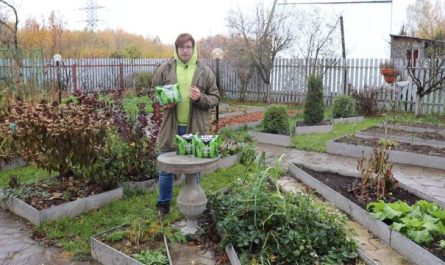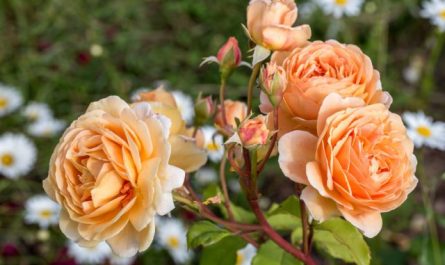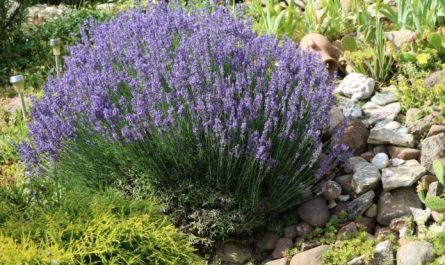Rhythms and repetitions play a special role in our lives. Therefore, it is not surprising that the most popular and successful techniques for arranging flower beds and borders in the history of landscape design were and remain rhythmic techniques. Born as a means of combating boredom and gloom when filling the area under hedges, rhythm in flower beds has become one of the essential tools without which it is impossible to achieve success in arranging complex compositions. The main enemy of monotony and this surprisingly simple technique of playing with rhythm allows you to create colorful, non-monotonous and emotional compositions.

Rhythm in landscape design is one of the most important techniques in the art of garden design, which gives the entire landscaping fullness, energy, coherence and dynamics, causes surprise and admiration, awakens emotions and sets the direction of the gaze movement around the garden, as if pushing it to move further. Rhythm controls perception and sensation, acts subconsciously and literally sets the tone of life in the garden.
The influence of rhythm on compositions is best explained by the problems it helps combat:
- boredom;
- monotony;
- facelessness;
- fatigue;
- irritation and anxiety;
- monotony;
- everyday life;
- inconstancy.
The ability to play with rhythm has always been especially evident in classic English gardens with their obligatory trimmed hedges, walking areas and serial mixborders. In fact, the concept of rhythmic design depends on the art of planting colorful perennials under boring green walls or fences, creating flower beds along the perimeter of the garden or a separate area with an amazing overall length.
Rhythm is a universal means of introducing variety into wide plant strips of great length and into compositions over a large area. In huge parks and estates, even the classic version with parallel flower beds running opposite each other and a lawn between them required special skill in preventing monotony and boredom. From aristocratic gardens with their huge areas, rhythm has today evolved into an important technique in the design of any, even a small flower bed, border, landscape group – as one of the basic tools in the arsenal of any landscape designer.
Rhythm in the art of garden design is a basic technique or means of constructing a composition along with symmetry and asymmetry, contrasts, scales, relationships of forms, etc. But, of course, it is rhythm that is the most emotional means of combating monotony. It is a universal means of “sharpening” all the decorative characteristics of complex compositions, bringing flower beds and borders to emotional and aesthetic “peaks”, giving them not just interest, but also aesthetic expressiveness and integrity.
Rhythm gives any composition integrity, orderliness, thoughtfulness and subdues any chaos, even color. And it “works” in any flower garden — with a dozen plant species, and with a hundred crops on neglected or unplanned flowerbeds, with any color palette. The ability of rhythmic techniques to limit, highlight, and organize the color range of compositions is unique: if you have overdone it with variety and variegation, then just 3-5 rhythmic elements will completely level out any shortcoming of an ill-considered play of colors and shapes.
In practice, rhythm is repetition, duplication of elements and distances between them. (or both of these components at the same time), creating the dynamics of the composition and introducing the effect of regularity into the design. To set the rhythm, the chosen motif (or element) must be repeated at least 3 times, but not more than 10 times, placing them at the same or thoughtfully changing distance. The greater the intensity, repetition of the rhythm, the stronger its emotional impact. But having reached a certain emotional limit, repetition can, instead of dynamics, on the contrary, increase monotony. Therefore, one rhythmic technique is not used “directly” more than 10 times, even in very large objects.

Depending on how complex the pattern and dynamics set by the rhythm are, rhythmic techniques are divided into two types:
Static or metric rhythm. For it, the selected object or element is repeated at the same distance. This trick is usually used in the regular style and minimalist projects with a focus on geometry, a ceremonial effect and classics. Static rhythm is often used when creating mixborders and flower beds, placing selected accents at the same distance along the middle line. The metric order, in turn, is divided into two types:
- simple, with one single element or plant, repeated at equal intervals – for small and short objects;
- complex, in which one or two more rhythmic alternations are added to a simple main rhythm – focal points or color spots that are spaced less frequently and at a different interval, different in nature, breaking up the monotonous basic rhythm and creating harmony of several repetitions at the same time (for very long borders and flower beds, large flower beds, carpet mixborders).
Complex or musical rhythm. Objects and distances change like musical compositions, “pulsate”, sometimes weakening, sometimes reappearing in full force. Such rhythm is used in landscape trends of landscape design and modern gardens without dominant minimalism. Most often, musical rhythm appears as a wave-like, spiral, intermittent (dotted) rhythm, but it can also be more original. You can experiment with such a rhythmic technique endlessly, using different objects at the same distance or, conversely, the same objects at different distances, playing on texture or details, spots of color, lines, etc.
Simple and complex rhythmic tricks differ in the intensity of their impact.. When used in a straight line, with equal distances and elements, the rhythmic effect is strong and concentrated. If you play with distance, placing rhythmic elements unevenly, the effect is slightly softened, there is no visual tension and obsessive impact. But then the flowerbed or border appears as more complex and multifaceted compositions, the details of which you want to examine endlessly.
The ability to give a flowerbed rhythm may seem very difficult in theory, but in practice it is not. Rhythm is intended to evoke emotions, and it is precisely these that should be used as a guide when creating flowerbeds, mixborders and flower beds in search of a means to make the compositions more expressive. Rhythm is not captured by the mind and vision, but by mood, impulses and feelings. And it is these that one should try to control when using rhythmic techniques, remembering that it is very easy to overdo it with them.
It is even easier to figure out what is what thanks to the fact that there are not as many tools or methods for introducing rhythm into decorative compositions as it might seem at first glance.
In fact, there are only two ways to play with the rhythm of the flowerbed:
1. Vertical accents. This is the most obvious, effective and easy to use technique. By introducing visual “peaks” into the composition and giving rhythm to the vertical relief, you create a basic rhythm in the composition. Verticals enliven any ensemble, give it expressiveness, change perception and fight boredom. And as vertical accents it is not at all necessary to use trimmed pyramids of yew or privet: this role can be performed by consistently, controlled placement of tall perennials, and statues, and shrubs, and even supports with flowering vines. It is not necessary to use only one plant: you can place groups of tall plants with repetitions and create complex “pyramids” and height differences to achieve a feeling similar to musical harmony.
2. Color and texture spots. Plants with a pronounced color or a contrasting size and type of leaves, planted in a group, located at the same or changing distance, do not immediately catch the eye. And their role in setting the rhythm is not always obvious. Color and texture accents are revealed gradually, but give much more emotion and expressiveness than vertical accents. Using a rhythm of color spots allows even a carpet mixborder not to look monotonous. Repetition of the same color or pattern of leaves can change from season to season, disappear or overlap each other and other rhythmic techniques. Thus, even hosta or fern bushes placed at the same distance can create a rhythm no less striking than trimmed boxwood spheres, if they are surrounded by plants without the same ornamental effect. And the soloists – roses used in the border, placed in a strict order, will give any ensemble rhythmic dynamics. And if you supplement the rhythm of the hostas with strict observance of the distances between the astilbe or heuchera bushes, then the basic textural rhythm will be supplemented by the color rhythm of other plants.

The easiest way to study the art of introducing and using rhythm in compositions is with large plants – trees and shrubs. Alternating fruit trees with berry bushes in an orchard, planting shrubs of the same species at equal distances along a path, using identical supports for vines in equal condition, stepping paths, series of identical flower beds or garden beds, alleys – all these are obvious examples of rhythm.
When it comes to flower beds and mixborders, flower beds and other types of compositions with dozens of plants, the rhythmic components seem much more complex. After all, it is necessary to take into account the interaction of dozens of factors and create relationships that provide dynamics without violating harmony. But everything remains as simple always and everywhere: rhythm is introduced as a separate repetition of a specific element or motif. The main difficulty with the use of rhythm by non-professionals lies in the distortion of the essence of rhythm and the need to “calculate” it (or rather, not lose it) in complex compositions.
Rhythm is a very simple technique, and only its perception and impact are complex and non-obvious.. It is precisely in the way rhythm changes our emotions and controls mood and movement that one can never speak of any one “object” in isolation: the effect is always built on interaction, the relationship of rhythmic orders with the environment and with each other. But this does not change the essence of the technique itself, accessible to everyone without exception.




















